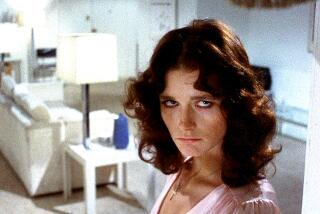TV REVIEWS : âPicture Windowsâ Trilogy No Artistic Masterpiece
Great art is not just great on its own terms, but for the inspiration it can provide to other artists--or so posit the producers of âPicture Windows.â But what if great art in turn inspires only mediocre art?
This aggressively middle-brow miniseries of six episodes--presented, pretentiously enough, in two âtrilogiesâ of unrelated vignettes--ostensibly takes well-known paintings as its creative springboard. But the connections between painting and story line tend to be superficial--a Degas ballet painting inspires, inevitably, a story about a ballet dancer, without evoking the originalâs tone or luminescence.
First, and maybe the most faithful to the seriesâ concept, is Norman Jewisonâs âSoir Bleu,â based on Edward Hopperâs painting of the same name. The camera zooms in on the sullen, cigarette-smoking clown of the painting, and dissolves into Tully (Alan Arkin).
The story itself is artlessly written melodrama concerning passion and violence behind the scenes of a traveling circus, but Arkinâs performance and Jewisonâs ability to squeeze impressive visuals from an obviously tight budget keep it fairly engaging.
No such luck with Peter Bogdanovichâs âSong of Songs,â which literally uses Sandro Botticelliâs âPrimaveraâ as mere window dressing--itâs on display in the storefront window of a new neighborhood lingerie shop that outrages the staid, listlessly married Ted (George Segal).
Nonetheless, when that shopkeeper turns out to be a dippy flirt named Blossom (Sally Kirkland), and when she delivers a monologue about penises that no one outside of Kirkland could deliver, Tedâs hopelessly smitten and, of course, due to learn a lesson or two. Alas, Bogdanovich canât decide how winsomely he should handle such predictable material, so nothing registers on an emotional level.
Tonal confusion is also a problem for Jonathan Kaplanâs âLanguage of the Heart,â inspired by Edward Degasâ âThe Rehearsal.â Itâs a generic love story thatâs both propelled and undone by a blustery performance by Michael Lerner that topples headlong into camp.
Lovely Anna (Tamara Gorski) is a struggling dancer for a ballet company who garners the unwanted attentions of the Maestro (Lerner). She tries to persuade him to help out her true love, the street musician Mischa (Joel Bissonnette).
Itâs hard to imagine anyone making a coupling of such ancient material and thin characters interesting, and Kaplanâs attempts at lush romanticism are at odds with Lernerâs brashness. Conversely, Lernerâs noisy bravado is the only thing of interest in the piece.
This episode points up a nagging problem with âPicture Windowsâ: All three of these stories could have been scripts sitting around that the programâs producers simply elected to shoehorn into this format. If âPicture Windowsâ produces further episodes, struggling writers with pre-existing short-film scripts should take note: Head for LACMA and nose around. Find a work of art that seems like it might peripherally relate to your script. Rewrite the beginning and end of your screenplay to incorporate the work of art. And let me know if it works.
* âPicture Windows,â trilogy I, airs Sunday at 8 p.m. on Showtime. Trilogy II airs Oct. 29 at 8 p.m. Individual episodes are sprinkled throughout Showtimeâs October and November schedule.
More to Read
The complete guide to home viewing
Get Screen Gab for everything about the TV shows and streaming movies everyoneâs talking about.
You may occasionally receive promotional content from the Los Angeles Times.






